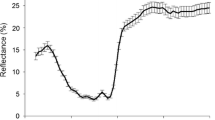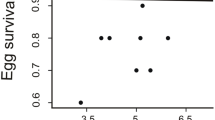Abstract
Carotenoid-based coloration is well studied in birds and fishes because carotenoid pigments must be acquired from the diet, and therefore it may be used as an honest signal of condition. Females may select males based on the color and intensity of the carotenoid pigments found in a high quality male. The orange patches on the pectoral fins and body of male Pygmy Sculpin (Cottus paulus) differ in aspects of coloration between successful and unsuccessful males (defined as nest holders who either obtain egg clutches or not); however, these males do not differ in length or condition. Within successful males, condition was correlated with mating success (average eggs gained and average egg clutches gained) but coloration was not. However, aspects of coloration were correlated with male condition. Female Pygmy Sculpin seem to prefer males with more intense coloration and that are in good condition, which may correlate with numerous benefits such as effective brood defense, decreased filial cannibalism and fungal infections.



Similar content being viewed by others
References
Andersson M (1994) Sexual selection. Princeton University Press, New Jersey
Barber I, Arnott SA, Braithwaite VA, Mullen W, Huntingford FA (2000) Carotenoid-based sexual coloration and body condition in nesting male sticklebacks. J Fish Biol 57:777–790
Basolo AL (1990) Female preference for male sword length in the green swordtail, Xiphophorus helleri (Pisces: Poeciliidae). Anim Behav 40:332–338
Bendich A (1989) Carotenoids and the immune system. J Nutr 119:112–115
Bendich A (1993) Biological functions of dietary carotenoids. Ann NY Acad Sci 691:61–67
Bergstrom CA, Whiteley AR (2012) The heritable basis and cost of colour plasticity in costrange sculpins. Evol Biol 25:2526–2536
Boschung HT, Mayden RL (2004) Fishes of Alabama. Smithsonian Institution Press, Washington DC
Braithwaite VA, Barber I (2000) Limitations to colour-based sexual preferences in three-spined sticklebacks (Gasterosteus aculeatus). Behav Ecol Sociobiol 47:413–416
Côté IM, Gross MR (1993) Reduced disease in offspring: a benefit of colonality in sunfish. Behav Ecol Sociobiol 33:269–274
Donald JA (1998) Autonomic nervous system. In: Evans DH (ed) The physiology of fishes, 2nd edn. CRC Press LLC, Boca Raton, pp 407–440
Endler JA (1980) Natural selection on color patterns in Poecilia reticulata. Evolution 34:76–91
Evans MR (1996) The importance of carotenoids in signaling during aggressive interactions between male fire mouth cichlids (Cichlasoma meeki) Behav Ecol 7:1–6
Frishchknecht M (1993) The breeding coloration of male three-spined sticklebacks (Gasterosteus aculeatus) as an indicator of energy investment in vigor. Evol Ecol 7:439–450
Goodwin TW (1984) The biochemistry of carotenoids Chapman & Hall. New York, New York
Grether GF (2000) Carotenoid limitation and mate preference evolution: a test of the indicator hypothesis in guppies (Poecilia reticulata). Evolution 54:1712–1724
Grether GF, Hudson J, Endler JA (2001) Carotenoid scarcity, synthetic pteridine pigments and the evolution of sexual coloration in guppies (Poecilia reticulata). Proc Royal Soc B: Biol Sci 268:1245–1253
Hill GE (2002) A red bird in a brown bag: the function and evolution of colorful plumage in the house Finch. Oxford University Press, New York
Hill GE, McGraw KJ (2006a) Bird coloration, volume 2: function and evolution. Harvard University Press, Harvard
Hill GE, McGraw KJ (2006b) Bird coloration, volume 1: mechanisms and measurements. Harvard University Press, Harvard
Hill GE, Hood WR, Huggins K (2009) A multifactorial test of the effects of carotenoid access, food intake, and parasite load on the production of ornamental feathers and bill coloration in American goldfinches. J Exp Biol 212:1225–1233
Höglund E, Balm PHM, Winberg S (2000) Skin darkening, a potential social signal in subordinate arctic charr (Salvelinus alpinus): the regulatory role of brain monoamines and pro-opiomelanocortin-derived peptides. J Exp Biol 203:1711–1721
Höglund E, Balm PHM, Winberg S (2002) Behavioural and neuroendocrine effects of environmental background colour and social interaction in Arctic charr (Salvelinus alpinus). J Exp Biol 205:2535–2543
Houde AH, Torio AJ (1992) Effects of parasitic infection on male color patterns and female choice in guppies. Behav Ecol 3:346–351
Jenkins RE, Burkhead NM (1993) Freshwater fishes of Virginia. American Fisheries Society, Bethesda
Jennions MD, Petrie M (1997) Variation in mate choice and mating preferences: a review of causes and consequences. Biol Rev 72:283–327
Johnston CE (2000) Allopaternal care in the Pygmy Sculpin (Cottus pygmaeus). Copeia 1:262–264
Johnston CE (2001) Nest site selection and aspects of reproductive biology of the Pygmy Sculpin (Cottus paulus) in Coldwater Spring, Calhoun County, Alabama. Ecol Freshwat Fish 10:118–121
Kirkpatrick M (1987) Sexual selection by female choice in polygynous animals. Annu Rev Ecol Syst 18:43–70
Kodric-Brown A (1989) Dietary carotenoids and male mating success in the guppy: an environmental component to female choice. Behav Ecol Sociobiol 25:393–401
Kodric-Brown A, Brown JH (1984) Truth in advertising: the kinds of traits favored by sexual selection. Am Nat 124:309–323
Kokko H, Brooks R, Jennions MD, Morley J (2003) The evolution of mate choice and mating biases. Proc Royal Soc B: Biol Sci 270:653–664
Manica A (2002) Filial cannibalism in teleost fish. Biol Rev 77:261–277
Marconato A, Bisazza A (1988) Mate choice, egg cannibalism and reproductive success in the river bullhead, Cottus gobio L. J Fish Biol 33:905–916
Marconato A, Bisazza A, Fabris M (1993) The cost of parental care and egg cannibalism in the river bullhead, Cottus gobio L. (Pisces, Cottidae). Behav Ecol Sociobiol 32:229–237
Matsuno T (2001) Aquatic animal carotenoids. Fish Sci 67:771–783
Mayne ST (1996) Beta-carotene, carotenoids, and disease prevention in humans. J Fed Amer SocExp Biol 10:690–701
McCaleb JE (1973) Some aspects of the ecology and life history of the pygmy sculpin, Cottus pygmaeus Williams, a rare spring species of Calhoun County, Alabama (Pisces: Cottidae) Master’s Thesis, Auburn University, Auburn, Alabama
McGraw KJ, Ardia DR (2003) Carotenoids, immunocompetence, and the information content of sexual colors: an experimental test. Am Nat 162:704–712
Møller AP, Biard C, Blount JD, Houston DC, Ninni P, Saino N, Surai PF (2000) Carotenoid- dependent signals: indicators of foraging efficiency, immunocompetence or detoxification ability? Avian Poult Biol Rev 11:137–159
Murphy BR, Willis DW (eds) (1996) Fisheries techniques 2nd edition. American Fisheries Society, Bethesda
Nicoletto PF (1991) The relationship between male ornamentation and swimming performance in the guppy, Poecilia reticulata. Behav Ecol Sociobiol 28:365–370
Nicoletto PF (1993) Female sexual response to condition-dependent ornaments in the guppy, Poecilia reticulata. Anim Behav 46:441–450
Olson VA, Owens IPF (1998) Costly sexual signals: are carotenoids rare, risky or required? TREE 13:510–514
Parsons E (2001) Breast coloration and algae consumption by Bluegill sunfish Master’s Thesis Coastal Carolina University, Conway, South Carolina
Rohde FC, Arndt RG, Foltz JW, Quattro JM (2009) Freshwater fishes of South Carolina. University of South Carolina Press, Columbia
Sköld HN, Svensson PA, Zejion C (2010) The capacity for internal colour change is related to body transparency in fishes. Pigm Cell Melan Res 23:292–295
Wedekind C, Meyer P, Frischknecht M, Niggli UA, Pfander H (1998) Different carotenoids and potential information content of red coloration of male three-spined stickleback. J Chem Ecol 24:787–801
Whiteley AR, Gende SM, Gharrett AJ, Tallmon DA (2009) Background matching and color-change plasticity in colonizing freshwater sculpin populations following rapid reglaciation. Evolution 63:1519–1529
Williams JD (1968) A new species of sculpin, Cottus pygmaeus, from a spring in the Alabama. River Basin Copeia 1968:334–342
Zahavi A, Zahavi A (1997) The handicap principle: a missing piece of Darwin’s puzzle. Oxford University Press, England
Acknowledgments
The authors would like to thank the staff at the Paul B. Krebs Treatment Plant and Anniston Water Works and Sewer Board for their support and for allowing access. The authors would also like to thank D. Holt and P. Speares for helping create the acoustic set-up as well as two reviewers for valuable comments to this manuscript. This work was funded in part by a Section 6 grant from the Alabama Department of Conservation and Natural Resources, and covered by Auburn University animal welfare protocol number 2011–2016.
Author information
Authors and Affiliations
Corresponding author
Rights and permissions
About this article
Cite this article
Kierl, N.C., Johnston, C.E. The relationship between breeding coloration and mating success in male pygmy sculpin (Cottus paulus Williams). Environ Biol Fish 98, 301–306 (2015). https://doi.org/10.1007/s10641-014-0260-9
Received:
Accepted:
Published:
Issue Date:
DOI: https://doi.org/10.1007/s10641-014-0260-9




